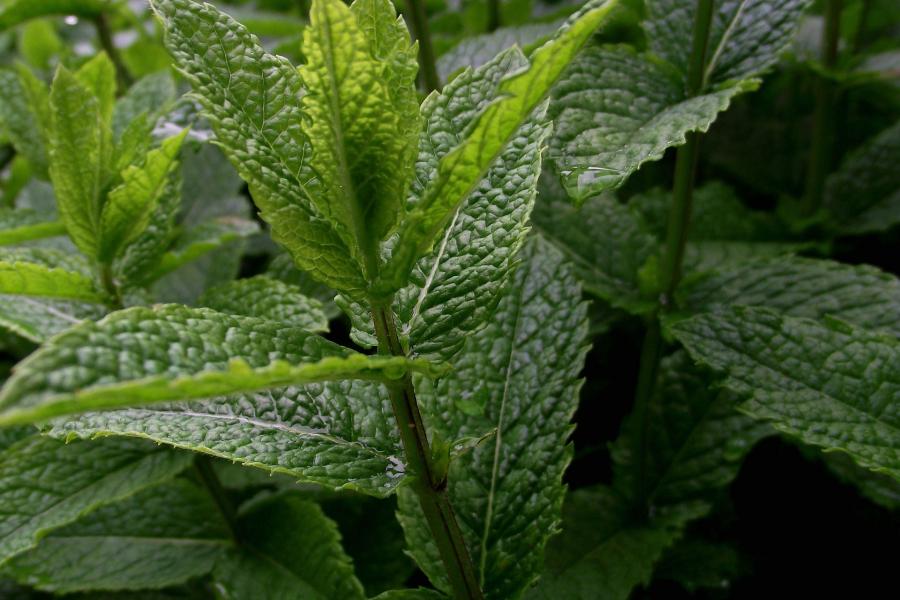Mint
Refreshing, aromatic, sweet flavor. Used in sweet or savory dishes.
Mint is an extremely versatile herb, complements dishes both sweet and savory from a wide array of cuisines, ethnic or else. It has the ability to bring freshness to any dish and not a subtle flavor at all.
Mint can be an ingredient in a main course or a dessert, sprinkled on a snack, used to enliven leftovers, or to bring the gourmet touch to a fancy dinner. You can enjoy mint at breakfast, lunch or dinner.
Curious Facts about mint
The Greeks believed mint could clear the voice and cure hiccups and mint still helps with hiccups, watery eyes, and headaches in children.
Peppermint and spearmint arrived to the New World with the early settlers, who would use them for medicinal purposes and to help them sleep. Colonists also drank mint tea for pleasure - it wasn't taxed- and mint became a sign of hospitality with time. Ladies and gentlemen in the South would sit on the veranda sipping mint juleps.
Peppermint is the most common today; you'll find it as a flavoring for candy, gum, and sweets, as well as toothpaste, cough drops, and other medicines. It is also used in beauty and health products, especially for oily skin and hair.
How to identify mint
Flowers and leaves have their characteristic flavor and refreshing aroma. Grown virtually everywhere in one of its many varieties.
There are several types of mints that one can choose from. It's best to have only 3 varieties on hand. Choice is always a personal preference.
- Spearmint is the most common culinary mint. Use it fro drinks - subtle mint flavor.
- Use peppermint for drinks and desserts - bold, pungent mint flavor.
- Moroccan Mint is used to make traditional mint teas - infuses better.
- Apple mint is a good flavoring for cold drinks, while it is hybrid - < em>a mix of apple mint and spearmint - is said to make the best mint sauce - aroma of mint and green apples.
- Ginger Mint is rated less among cooks because it desn't have strong mint flavor.
- Lemon Mint is good in drinks and used as a potpourri -mild mint and citrus aroma.
- Pineapple mint is good for salads and cooking - subtle mint and pineapple flavor.
- Chocolate mint smells slightly of chocolate and is good in desserts.
Regardless of the type you choose, all mints have the volatile mint oil, menthol, which gives it that characteristic cooling, cleansing feeling when you taste it.
How to use and store mint
Mint mixes with fruit salads, cheese or yogurt, omelets, lamb and chocolate. Eat mint with zucchini and broad beans; drink mint tea or use it to enhance the delicate flavor of sorbets and ice creams... or rum.
Mint comes as an oil or extract -both often used in baking. Mint leaves can be used fresh or dried -young leaves are better when using fresh mint, as mint leaves become bitter in time.
Mint is a truly international ingredient, used in western cuisine -roasted lamb and mint sauce- middle eastern cuisine - minty meatballs - and eastern cuisine -Thai green chicken curry, Indian mint chutney, or Vietnamese vermicelli. You'll find mint in Greek spanakopita or Cuban mojitos.
How to grow mint
Mint grows, no problem in this quarter, despite not getting much water and having indifferent soil. Planted or potted, mint will add a nice fresh scent to any home.
Cooking with mint
For mint tea, use the mint of your choice, you will need 1 oz (15-30 g) of fresh mint soaked in 1 pt (½ l) of boiling water. The stronger the mint, the more pick-me-up you will feel. If you want a more sedative effect, pour ½ pt (300 ml) of boiling milk over a tablespoon of crushed leaves.
Mint substitution - if a recipe calls for mint and you don't have it, substitute 1 Tbs chopped fresh mint with:
- 1 tsp dried mint
- 1 tsp dried mint from herbal mint teabag
- ¼-½ tsp mint extract
- 1 drop peppermint oil
- 1-3 Tbs mint cream -reduce liquid by 1-3 Tbs and reduce sugar if necessary
- 3-4 Tbs peppermint liquor -reduce liquid by 3-4 Tbs if necessary
- 1 Tbs chopped fresh parsley -only savory dishes
- 1 Tbs chopped fresh basil -good in sweet and savory dishes
Mint sauces or chutneys have their own substitutions.
Cooking your way with mint
Mint can be candied, it can be dried, and is really great fresh in any meal. Spoon it into yogurt, sip it in tea, and whip it into cream to make a nice dessert topping. It matches wonderfully with most fruits. The freshness quality in mint is the perfect counterpoint to the sweetness in blueberries, mangoes, and watermelon. Try strawberries with sweet wine and mint, or, more exotic, with balsamic vinegar and mint.
Try mint in your pesto sauce by replacing the basil, or chop and sprinkle over a salad.
To make mint ice cream you might want to use Moroccan mint, it tends to be the most flavorful, yet any of the above mints varieties will work. Pick the leaves and wash them well. Chop them until you have 2 full cups and pour boiling water over the foliage, stir in sugar and allow it to cool before adding your cream. You want it in proportions of half cream to half syrup. Then freeze.
Why don't you try to make mint brownies?
spearmint, mint - mentha spicata (labiatae)
French menthe
German minze
Italian menta
Spanish menta

